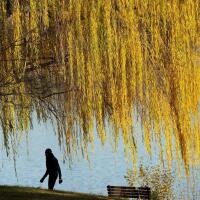Challenging What We Take for Granted in the Plant World: A Conversation With Gardeners and Other 'Plant People'

This article is part of a series, in collaboration with the Civic Paths working group at the University of Southern California.
“The first thing the plants would say is: Without us, you're going to be dead. It's a long-term relationship that you take for granted." This is what Andy*, a community gardener in Los Angeles, exclaimed when asked what her plants would want to say about climate change.
For us at the Civic Imagination Project at Civic Paths Group/USC, tapping our creativity and connecting to culture around issues of shared concern activates the civic imagination, which we define as the practice of visualizing any social change that supports moving towards a better world.
An essential element is our ability to understand ourselves as civic agents capable of enacting change.
But paths of civic imagination must also be explored with others; one must respect the perspectives of others, and ultimately navigate imaginative possibilities with the communities one comes from or chooses to belong to.
Civic imagination may express desires for liberation or equality not yet fully realized; it may also guide such change. In our work, we bridge between theory and practice to support the civic imagination as people engage with activities and interests they already have, including food, popular culture, parenting and now plants.

Through this project, we have come across a wide array of references encouraging us to challenge our taken for granted relationship to the plant world, including "Braiding Sweetgrass" by Robin Wall Kimmerer, "Plants and Other Science Fictions" by Veronica Hollinger, "The Overstory" by Richard Powers and "Botany of Desire" by Michael Pollan, to name a few.
Drawing on this growing awareness of the plant world we are inextricably embedded in, we want to understand how we might motivate and connect with people who care about plants — but who do not necessarily think of themselves as activists around issues of climate change and ecological social justice.
This is why we set out to talk to gardeners, flora painters and florists to understand plants and the civic imagination — and to learn more about imagining with plants to respond to climate change.
Speaking with gardeners and others working with plants also helped us understand the emotional relationships people form with plants and how these connect to other areas of our lives.
Here are the key themes that emerged from our interviews with Andy and others:
Plants Are Wise
The gardeners, artists and florist we spoke with all agreed that the plants they tend for have wisdom to share.
For gardener and artist Natalya, it was a dandelion pushing through the cracks of a paved sidewalk that has "a lot to teach us about resilience."
For Meredith, an active gardener now in her 60s, the plants know that we are "all connected," all part of the animal-plant kingdom. They also know we all need to "get our act together."

As a florist, Anna arranges cut flowers for all kinds of occasions — and acknowledging the fact that plants do die helps her appreciate the "sunrises and sunsets" even more. For her, plants know a lot about the "transience of life." In her words, "Each day comes and goes. We are not here forever. And, it's beautiful."
As gardener and artist Alec explained, "Nothing really ends. Everything changes. That is something that you see in a garden. It's a cycle you have to respect."
Plants Inspire Stories
Plants show up in many folk tales, films and poetry — and the gardeners and others we spoke with were quick to come up with examples that had influenced their relationships to plants.
There was Robert Frost's classic poem “The Road Not Taken." Beatrix Potter's "The Tale of Peter Rabbit" was also popular, with most people identifying with Mr. McGregor!
For Tom, a teacher in San Diego, it was Shel Silverstein's "The Giving Tree," in which a tree supports a boy as he grows, matures and ultimately gets old. For many other gardeners it was "Jack and the Beanstalk," a classic tale in which a giant bean plant becomes a gateway into a fantastical world where giants roam.
Others reminisced about the version of "Sleeping Beauty" in which rose bushes take over the castle after the protagonist pricks herself on a thorn and falls into a deep slumber. Recasting the role that the rose bushes play in the story, the gardeners said they believed the bushes protected the title character until she was ready to wake up. Still others talked about stories rooted in Native American, Japanese and other traditions.
Plants Remind Us of the Cycle of Life
Most of the people we spoke with were not religious, and yet many of them shared that plants connect them to something they would describe as almost divine. Alec quipped that even the Bible teaches us that God created a lush garden before he created human beings.
In this light, plants serve as a reminder of what might be possible, from seed to compost.

In the words of another gardener, Kevin, "A seed is magic."
Anna, the florist, told us the flowers she works with remind her that "every day is different. And all of nature teaches us that [life] is not infinite."
From "Mother Nature" to a deeper truth about life, the people we spoke with said that plants remind them of something, or some power, that is much bigger.
Plants Talk — We Should Listen
The gardeners and artists we met were convinced that plants communicate with them.
Dave, a community gardener in Los Angeles, checked in with his plants everyday. He touched their leaves. He made sure their soil was healthy.
Tom said. "I'll see a plant that looks like it's going to die … then pay a little more attention to it. The next thing you know, things are back to normal. All I do is go check on it, touch the flowers, look at them. I don't water extra. It seems like that attention does it."
Meredith said she believes gardeners are really "plant whisperers" — and that plants know when someone cares about them.
Greta, one of the 15 gardeners we spoke with, said that when she has talked to her plants — said, "Hello, how are you?" — she knew her plants responded.
Plants may not have vocal cords, but they gave her plenty of visual cues about what they cared about and needed, prompting her to remove bugs or otherwise care for them.
Plants Care for Us, And We Care About Them
The gardeners we spoke with had feelings for their plants, and sometimes these feelings ran very deep.
One day, Tom came to the garden to discover that one of his older plants had finally died. The pandemic was raging then — and Tom told us that he felt like he had just lost an old friend. As he removed it, he couldn't help but notice that he was also now gray, old and aging, just like the plant he just lost.

Martin said he sometimes wondered if he helped or hurt his plants when he pruned them.
For Andy, caring for her plants fulfilled her — taking care of something settled her mind, she said.
Plants Evoke Memories
Andy's voice dropped while she described her memory of playing in the rain as her mother, who had recently immigrated to the United States, bent over the vegetables she was growing in a small patch by her house. At that time, her family could access Asian vegetables they wanted to eat only if her mother grew them. Her mother learned her farming from her mother, and her grandfather before that, imbuing the vegetables they grew with many-cross generational memories.
Dave had a similar story to share. He remembered his father taking care of other people's gardens, cutting hedges, cutting grass and maintaining flower beds — and teaching Dave how to tend to a garden as well.
Jane, a painter, always thought of her grandmother whenever she saw a blue flower.
And although Kevin's father moved a lot, he always had a garden. At first, Kevin scorned gardening, but he eventually picked it up as a way to connect with his father's values and worldview.
Plants Invite Us to Slow Down
"People should slow down. When they go to the garden, they shouldn't just try to get the next picture, the next picture and the next picture. They shouldn't walk by plants so quickly." Elaine, a painter based in South Pasadena, said. She shared her hope that more people would take the time to notice the plants around them.
Tom tells the kids in his class to slow down because there are "amazing things to find" if you do.
Elaine agreed, recounting how when she took time to sit with her flowers — allowing the plants to center and reset her — her mind stopped racing. She was able to experience the moment.
For Andy, plants altered the passage of time because they grow on their own schedule. In her words, "You plant a seed, and 20 years later, you may have a tree."
Are you interested in exploring how you might connect with plants to inspire your civic imagination? Try out one of our Plant and Civic Imagination activities. Instructions can be found here.
*Per interview guidelines for our study fielded through the USC, the names of all interviewees have been replaced with pseudonyms. The interviews were carried out by Molly Freezell, Paulina Lanz, Steven Proudfoot and Sangita Shresthova.








